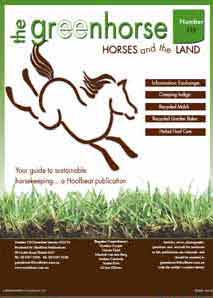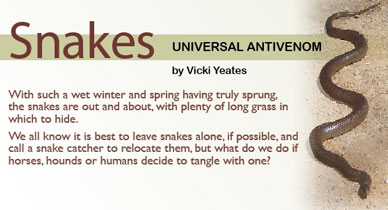The Green Horse section provides practical information on managing environmentally sustainable horse properties, readers stories and tips, as well as advice and articles from equestrian experts in their fields.
October/November 21
Vol 43 No 3
In this issue of The Green Horse you will find the following articles
Give Ticks The Flick
by Rhiannon Brown - Envirapest
Ticks! Who would have thought that a tiny, blood-sucking insect could cause such damage to large animals like our horses, dogs, cattle and even us?
But they can, and do.
It Is Going To Be A HotSsummer
by Catherine Bird for Country Park Herbs
Using Herbs to assist with modulating how the body copes with extremes of heat or cold can be traced back to the energetic approach of herbalism.
Tractor Accessories For The Horse Property
While a tractor is a significant purchase, its price will generally increase with the addition of implements, without which a tractor’s uses can be limited.
FENCING OPTIONS
by Liz Tollarzo
Every fence type has its pros and cons – knowing these can assist in deciding what will work the best for your needs – balancing the desired appearance, costs, safety issues, age and type of equines and ongoing maintenance.
WIN A YEAR'S SUBSCRIPTION...
share your equine property management tips and each issue one reader will win.
Send ideas to -
The Green Horse Support <greenhorse@hoofbeats.com.au>


PREVIOUS ARTICLES
Available on line
August/September 21
BEAT THE BINDI
by Rhiannon Brown - Envirapest
The prickly weeds that grow on our properties across Australia usually have long classical Latin names, are often known by a variety of common names in different localities but are regularly called very rude names when we happen to stand on one (or a dozen) or when they find our hands as we are dislodging tangles in the horse’s mane or tail.
June July 21
BARN OWLS by Wendy Elks
A silent partner in rodent control.
Non-toxic pest management is the most humane and ecologically sustainable way of bringing nature back into some kind of balance during non-plague times.
April/May 21
LOVELY LAWNS
by Rhiannon Brown - Envirapest
On a horse property there always seems to be hectares of grass, but we all have that little bit of lawn we want to look luscious all year round.
It could be the entrance to the stables, laneways bordering the driveway, that little ‘special’ snack paddock or you could even dream of a beautiful green arena. So, how do we achieve this?
Feb/March 21
STABLE DANGERS
by Elizabeth Tollarzo
They say that horses are accidents-waiting-to-happen as they are inclined to find every conceivable way to injur themselves, usually just before a competition. Being aware of potential dangers in the stable - and addressing these - may help aleiviate injury.
Dec/Jan 20/21
HORSES AND HONEY BEES-
Can they share space on the property?
by Wendy Elks
Oct/Nov 20
SOLAR-POWERED PRODUCTS
by Celine Bønnelykke
In previous issues we have discussed the economics of setting up a solar-driven property, but if finances don’t stretch to installation of the whole package, there are ways to ease into the solar-world.
Aug/Sept 20 THE HIDDEN DANGERS IN OUR PADDOCK.
by Elizabeth Tollarzo
Horses love to run, play, buck and then run again and we often, through lack of risk assessment or management practices, place them in areas that are fraught with dangers.
JUNE JULY 20 GOING SOLAR ON THE HORSE PROPERTY Where to put your panels Part 2
Once you have selected what solar system best suits your needs, then you need to look at how you can maximise the advantages.
APRIL MAY 20 GOING SOLAR ON THE HORSE PROPERTY Part 2
Once you have selected what solar system best suits your needs, then you need to look at how you can maximise the advantages.
FEB/MARCH 20 ANTS AWAY
by Mark Brown Envirapest
So, what can you do to deter ants from your house and your stables??
DJ19/20 KEEPING SNAKES OUT OF THE STABLE by Wendy Elks
Snakes may be protected under Wildlife regulations in Australia, and they may be great for keeping the mice and rats down, but do we want to find them in our stables near our horses and pets?
ON19 - TERMITES- common myths
by Rhiannon Brown, Envirapest
Your house and stables are looking wonderful this spring, but do you know what is happening inside the walls of your brick or timber building?
AS19 - OUCH THAT HURTS
by Catherine Bird for Country Park Saddlery
The extent of the swelling is usually an indication of the severity of the infection or injury and the cause needs to be established before giving herbs.
JJ19 - MANAGING PASTURE
by Rhiannon Brown, Envirapest Healthy pasture means healthy horses.
A/M19 - STOP THOSE WEEDS
Property biosecurity
by Rhiannon Brown, Envirapest
Putting simple precautionary steps into place can make it tough for weeds to get a hold on your equine paradise.
|
  
  


The good news is, there is no longer any need for a snake to be identified to administer antivenom. A universal antivenom is now used that covers the five genus of snake that will cause serious harm or death.
Whilst most bites occur on the muzzle and legs of dogs and horses, people are most likely to be bitten in a muscle mass. A common misconception is that venom is injected into the blood stream – but the snake actually needs to hit a vein to do that.Venom is transported through the body via the lymphatic system, which does not move through the body the same way as blood.
MOVEMENT triggers circulation of lymphatic fluid, so it is vital to keep the snake bite victim still.
Unfortunately, it is extremely rare for us to actually see a horse or dog bitten, and finding the puncture site can be difficult. Therefore, we discover them after the fact and already in distress. Veterinary assistance is vital.
Horses often present with symptoms similar to colic or salmonella poisoning, which can make diagnosis harder. If you strongly suspect snake bite it is imperative you notify the vet so adequate diagnosis and treatment can begin.
Dogs will be visibly affected – panting, bleeding from mouth, nose or anus, muscle tremors, ataxia and collapse. Veterinary treatment is urgent and it is vital to keep your dog as quiet as you can.
Humans are a bit of a different story. KEEP STILL!!! Call 000. Don’t go all ‘cowboy’ and suck out the venom or cut the wound. NEVER apply a tourniquet.
Apply a bandage over the bite site – do not remove clothing - to an area about 10cm above and below the bite site. Using another stretchy bandage (polo wraps or elastic tendon bandages work well), apply a firm bandage to the limb from fingers/toes to the very top of the armpit or groin.
The bandage should have about the tension of a sprain bandage but not so tight as to turn fingers or toes purple.
Splint the limb so the person can’t walk or bend it. Remain calm – you’ve got about 12 hours (depending on the type of snake).
Angry or scared snakes bite, so clean up your long grass, spring clean your feed sheds and kennels and call your friendly local snake catcher to come and relocate any you find. Chances are, when you see a snake it is more afraid of you than you are of it.
|